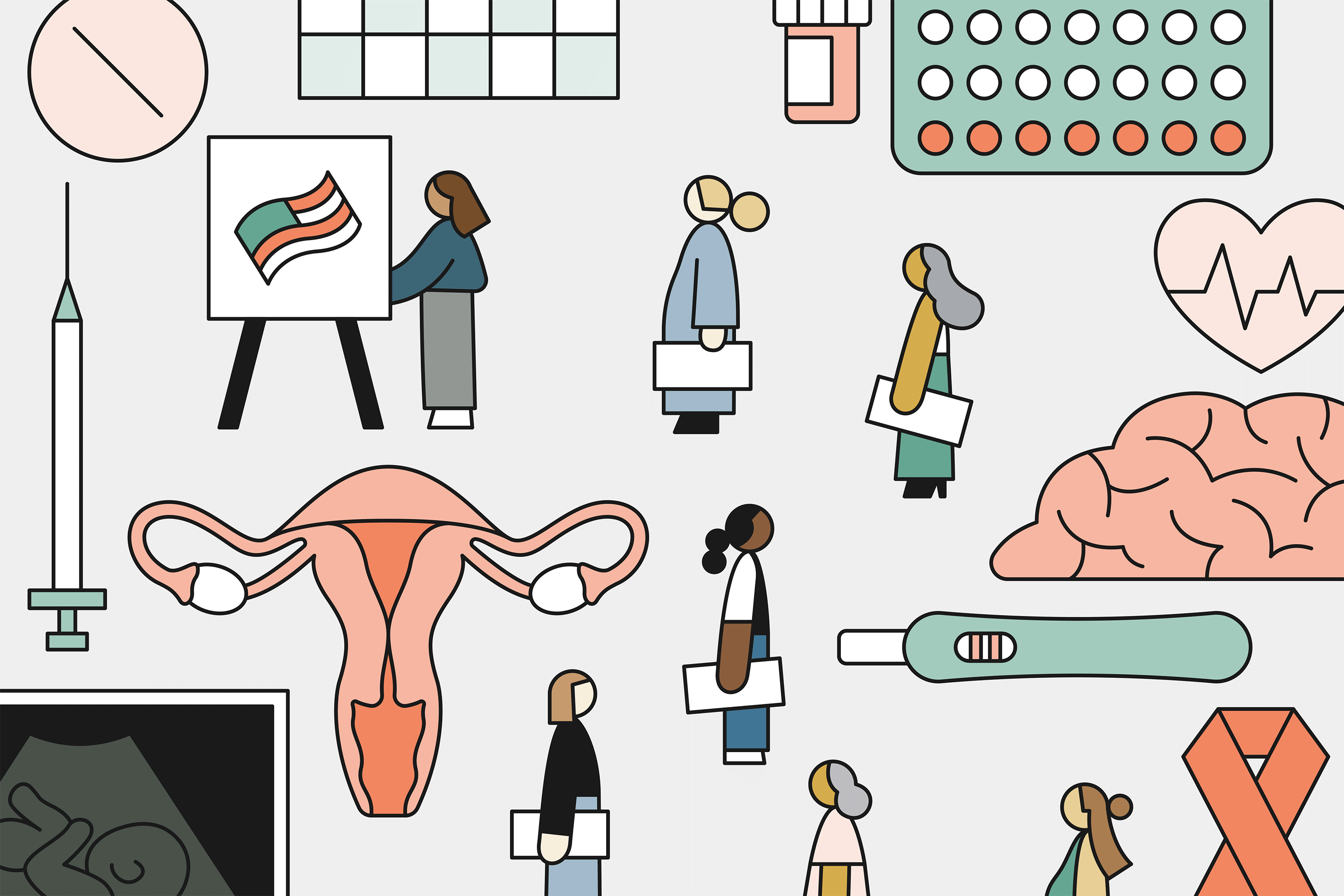In the United States, women’s access to health care — including abortion and reproductive services, which were significantly limited by the overturning of Roe v. Wade — depends, in large part, on the state they live in. Where women live also determines how likely they are to have a healthy pregnancy and safe delivery, as well as their risk of dying from preventable causes like substance use and certain cancers.
Women in the southeastern U.S., for example, have lower rates of access to affordable coverage and worse health outcomes compared to women in other regions, according to data from the Commonwealth Fund’s state scorecard on women’s health. In southeastern states — several of which haven’t expanded Medicaid, a key source of preventive and maternal health care coverage for people with low incomes — women are more likely to be uninsured.
The outcome of the election could affect women’s health care coverage and access in several ways. Here’s what’s at stake for women’s health across the nation.
How could the 2024 election affect coverage of and access to women’s health care?
By strengthening or restricting Medicaid funding. A Trump administration could reduce federal spending for Medicaid, as outlined in the Project 2025 policy initiative and the Republican Study Committee’s Fiscal Year 2025 budget proposal, and adopt policies focused on identifying fraud, waste, and abuse. Rolling back Medicaid funding would likely weaken postpartum coverage and present additional challenges for low-income women who need preventive health services before, during, and after pregnancy.
A Harris administration would likely continue to use federal levers to expand or enhance Medicaid coverage, such as through new models of whole-person maternal health care (akin to the Transforming Maternal Health Model) and continuous eligibility for children beyond the 12-month coverage period. It also would likely continue to allow states to use Medicaid funding to address health-related social needs, in recognition that health and well-being are shaped by factors, like housing and nutrition, that are beyond the health care system.
By strengthening or restricting Title X funding for family planning and preventive services. More than 4,000 Title X clinics across the country provide low-income and/or uninsured patients with family planning services, prenatal care, cancer screenings and other preventive services, and linkages to primary care. In 2022, some 2.6 million people received free or low-cost care at these clinics. For many women, Title X clinics are their only touchpoint for health services — especially for those living in rural communities. Policies put in place during the first Trump presidency drove nearly one-third of family planning clinics to leave the public health safety net. The Biden–Harris administration reversed these policies and helped rebuild the network.
If Trump is elected for a second term, Title X funding would likely be targeted again. A Harris administration would be expected to strengthen access to family planning and preventive services through Title X clinics.
How could the election affect access to abortion and other reproductive health care services?
Election results could determine the degree to which U.S. women have access to these health services.
Emergency abortion care under the Emergency Medical Treatment and Labor Act (EMTALA). Shortly after the U.S. Supreme Court’s Dobbs v. Jackson Women’s Health Organization decision that overturned the constitutional right to an abortion under Roe v. Wade, the Biden–Harris administration affirmed that abortions may be appropriate for patients with emergency medical conditions under EMTALA. In June, the Supreme Court decided to temporarily allow abortions in medical emergencies in Idaho. A second Trump administration could interpret EMTALA differently and reduce access to emergency abortion care, in at least some states. Dismantling or undermining EMTALA could result in disproportionate harm to underserved populations, legal uncertainty, and a potential chilling effect on the provision of emergency services more broadly. This represents a significant risk to reproductive health and access to emergency health care for pregnant individuals and possibly others.
Medication abortions. In a unanimous decision in June, the Supreme Court preserved access to mifepristone, which is used along with misoprostol for medication abortions. A Trump administration may direct the U.S. Food and Drug administration to reverse its approval of the drug combination for abortions or issue policies that restrict access to medication abortions, which could have wide-ranging impacts for women of reproductive age.
Contraception. While a Harris administration could build on Democratic efforts to strengthen access to contraception following the overturning of Roe, a Trump White House may weaken Affordable Care Act policies that cover contraception (including emergency contraception) at no cost by restoring moral exemptions to the coverage requirement. A Harris administration could mandate no-cost coverage of over-the-counter birth control, an unlikely move in a second Trump term.
How could the election affect efforts to address women’s health disparities?
Maternal wellness has strong backing in both political parties. A Harris administration would likely build on this administration’s blueprint to drive maternal health equity and address racial and ethnic disparities, such as the disproportionately high rates of maternal mortality among Black and American Indian/Alaska Native women. For instance, the Biden–Harris administration has highlighted its efforts to close gaps in women’s health research, grow the maternal health workforce, and launch the maternal mental health hotline.
A Trump administration may build on strategies outlined in the Action Plan to Improve Maternal Health in America released by the U.S. Department of Health and Human Services in his first term, which included specific goals to reduce maternal mortality, decrease low-risk cesarean delivery, and achieve blood pressure control for women of reproductive age with high blood pressure. Trump also could build upon the Preventing Maternal Deaths Act he signed in 2018, which sought to eliminate disparities in maternal health outcomes by expanding support for maternal mortality review committees.
Some common ground for both Republicans and Democrats could be efforts to improve women’s health in rural areas by targeting “maternal health deserts” in counties lacking maternity care. Although better access to women’s health care could be popular among rural Republican and Democratic supporters, potential Medicaid cuts proposed by Republican lawmakers, along with policies that restrict reproductive health services, could hamper such efforts.
What can U.S. policymakers do to strengthen women’s health care?
To improve women’s access to comprehensive and affordable health services across the U.S., the next administration could take several approaches.
Ensure access to the full spectrum of reproductive health services. That includes emergency abortion care under EMTALA and over-the-counter contraception, as well as the range of community-based models that can improve outcomes and the patient experience.
Invest in the country’s safety net. Policymakers could improve access to health services by investing in community health centers and other safety-net providers that women with lower income often go to for primary and preventive care. Efforts could also be made to strengthen the Title X program.
Expand access and coverage through Medicaid. Preserving the enhanced postpartum Medicaid coverage could help address racial and ethnic differences in maternal health outcomes. Continuing to help eligible people get enrolled and stay enrolled could reduce administrative hurdles and preserve continuity of care. To improve access to care, policymakers could help build and support a more diverse workforce through strategies like setting more equitable Medicaid reimbursement rates across states for midwives and other maternal health professionals.
Review women’s health outcomes by race and ethnicity and direct resources to address differences. That includes improving comprehensive data collection and analysis by maternal mortality review committees and perinatal quality collaboratives to better address preventable fatalities and drive quality improvement.
Commit to more research on women’s health. Policymakers could build on the Biden–Harris administration’s initiative to promote research that not only improves understanding of diseases and conditions that disproportionately affect women, but also leads to better prevention, detection, and treatment.
By implementing policies to strengthen women’s health, lawmakers could help mend the fractured landscape of women’s health care in the United States. They could ensure that women have timely access to care, no matter where they live. This November, voters will face a choice between two starkly different policy approaches, one that is likely to have a direct impact on the health of American women.



